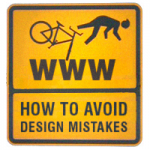Are You Making These Mistakes In Your Web Designs?

“With today’s snazzy and competitive Web 2.0 and social media world, universal design is many times forgotten. It’s bewildering as to why since there are many social, technical, financial, and legal reasons which support universal design practices. Let’s discuss some of the more prevalent issues in websites today, and how they relate to the main universal design principles.
The Principles
First, let’s review the seven universal design principles including some web-related examples. Keep in mind that these principles are applied, of course, to many industries outside of computer and web, such as civil engineering (buildings, walkways), entertainment (movie theaters, theme parks), and transportation (buses, trains).” [Go to full article]
Create An HTML/CSS Mobile Web App Using Sencha Touch

“The world of mobile app development is quickly becoming a crowded and complicated space, especially for those outside of the development niche. Which development platform should I use? Do I go native or Web-based? Which devices should I plan for? Can I build my mobile website by hand or should I use a pre-built package? The questions are endless.
As a designer, my job is to help my clients answer these questions. I try to stay in the category of knowing enough to be dangerous, and I keep tabs on the latest mobile development trends, one being the growing popularity of mobile Web apps.”
7 Guidelines For Designing High-Performance Mobile User Experiences

“A positive first impression is essential to relationships. People look for trust and integrity, and they expect subsequent encounters to reflect and reinforce their first impression. The same principles apply to brands and their products. Design plays an important role in building lasting relationships with end users and, thus, in supporting the brand’s promise.
Users expect mobile services to be relevant and user-friendly and to perform well. The limitations of the medium, however, impose significant challenges to designing products that meet all of those expectations. While often underestimated, performance is a crucial contributor to a trustworthy mobile user experience. Therefore, it should be considered a key driver in the design process.
In this article, we’ll discuss performance in relation to design and present seven guidelines that can help shape design decisions related to performance while accounting for the needs of end users and businesses. These guidelines are based on the experiences of our teams in designing native mobile apps for a broad product portfolio and on multiple mobile platforms.”
Create a Settings Page For Your WordPress Theme

“Creating your own theme for WordPress is a great way to give your blog or other WordPress powered web site an original touch. But even the nicest looking theme is not that nice if you have to get under the hood and edit the theme’s HTML or PHP code whenever it’s time change some aspects of it. Especially, when it’s not you but a paying customer using your theme. Luckily, creating a settings page for your theme in WordPress is not very hard, and after reading this tutorial, you will be able to create one in no time!”
Learning To Use The :before And :after Pseudo-Elements In CSS

“If you’ve been keeping tabs on various Web design blogs, you’ve probably noticed that the :before and :after pseudo-elements have been getting quite a bit of attention in the front-end development scene and for good reason. In particular, the experiments of one blogger namely, London-based developer Nicolas Gallagher have given pseudo-elements quite a bit of exposure of late.
To complement this exposure (and take advantage of a growing trend), I’ve put together what I hope is a fairly comprehensive run-down of pseudo-elements. This article is aimed primarily at those of you who have seen some of the cool things done with pseudo-elements but want to know what this CSS technique is all about before trying it yourself.
Although the CSS specification contains other pseudo-elements, I’ll focus on :before and :after. So, for brevity, I’ll say ‘pseudo-elements’ to refer generally to these particular two.”
Google SEO Basics for Beginners

“As many of us web developers already know, Google is rated by many as the number one search engine in the world. We personally know that our websites get about 90% of their search engine traffic direct from Google searches.
Getting indexed by Google can be a pain, but getting highly placed rankings for specific keywords seems to be the nut that not many web developers without SEO (search engine optimization) experience or seo training can crack.
Today we’re going to give you an informative primer on the basics of search engine optimization techniques many of which we use everyday to optimize our websites and stay ahead of our competitors.”
[Go to full article]
How to Teach Someone Graphic Design

“Do you have a friend, family member or colleague who is considering design as a profession and looks to you for guidance? Your instruction could mean the difference between a meaningful career and a non-starter.
Today we’ll offer up some basic advice that everyone should consider before attempting to teach someone to be a graphic designer.”
50 New And Crazy Cool jQuery Plugins From Year 2011

“With 2011 a little over half over it’s the right time to look at, and uncover, the current trends of web design and development. It’s sure been a helluva ride for jQuery and it’s growth just doesn’t stop. With more than 40% of websites using jQuery now it’s no longer possible to ignore this efficient, powerful and lightweight tool.
jQuery gives developers the chance to enrich websites with amazing elements without the need to write dozens of lines of code. This article presents 50 advanced, cutting-edge yet simple jQuery plugins that will enhance your web experience drastically.”
20 Ways To Promote Yourself As A Web Designer

“Web Designers can often find it hard to get their name out there, and begin getting clients. Promotion doesn’t always have to cost money. I have compiled a list of how web designers can promote themselves, and get their name out there. Some of the ways require little to no effort, whilst others require much time. Either way, you will still receive more clients.”



